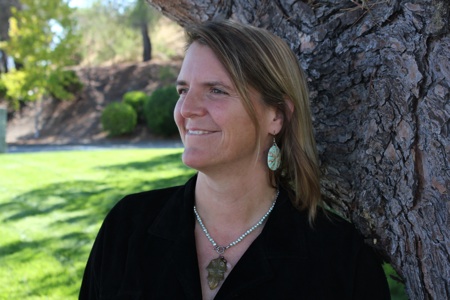During her two years at the Environmental Protection Agency designing the first Energy Star programs, Cyane Dandridge lamented not being able to “see change happen” on the ground. So she found work closer to her heart, founding an environmental consulting firm dedicated to helping communities reduce their greenhouse gas emissions, then co-founding the first school of environmental leadership in the country – the Marin School of Environmental Leadership (MarinSEL) at San Rafael’s Terra Linda High School.
BN: Where did you grow up?
CD: I moved around a lot growing up, living in eight states and two countries. If I grew up anywhere, it was in Wellfleet on Cape Cod, in Massachusetts. Before coming to Marin in 1995, I’d never stayed longer than four years in one place, but I’ve lived here ever since.
BN: You founded an environmental consulting firm and then co-founded a school. Was being an entrepreneur always in the cards for you?
CD: It was a direct road with a few side trips to start several businesses – a windsurfing school, a cleaning service …. My father was a small business professor, so I grew up knowing that I had to be an entrepreneur, even though I worked for the EPA for a while.
BN: But entrepreneurship with an environmental bent, right?
CD: Yes. At Reed College, I studied physics and really wanted to do work around ways of looking at solar energy. I found out that the people who were installing the solar panels didn’t understand the technology involved, and I decided I wanted to bridge that knowledge gap, so I went back to school at MIT and put that into practice at the EPA designing some of the first US Energy Star programs. But after two years working in the federal government I realized that what I was doing was so high-level that I wasn’t seeing change happen. I wanted to get involved on a community level, so I took the reins at an DOE-funded nonprofit in Berkeley called ReEnergize. Later I started my consulting firm to help communities develop their own energy conservation goals.
BN: What inspired you to develop MarinSEL, this “school within a school”?
CD: I love my kids, and I want to make sure they have every opportunity to excel. I believe two things; people learn more by doing, and the environment is one of the most challenging and important issues our world is facing now and for many years to come. I was inspired by my own children to start the school; the design came from my own background and from what I think is most important for education.
BN: Can you describe the Marin School of Environmental Leadership?
CD: The Marin School of Environmental Leadership is a school within Terra Linda High School that combines the breadth and diversity of a typical public high school with the depth and integrated learning of project-based education. The program has its own curriculum for ninth and tenth graders, who also take a few regular high school courses on top of the MarinSEL courses.
The courses have a core environmental focus: Teachers guide students through inquiry-based projects where they apply theories from multiple disciplines to address real world environmental and social issues in our community. Through this process, students have a sense of interconnectedness between themselves, their community, and the earth.
At the end of each semester, students participate in two weeklong periods of project-based learning, where they focus exclusively on projects of their choosing that have a service element for the school or community. Students identify a question such as “What is the impact of plastic water bottles on the Terra Linda campus?” Working in groups with a teacher and community partner, students research the issue, plan a strategy to solve an identified problem, carry it out, and share their findings with the community.
We also do a lot of work around team-building: helping young people understand how to communicate effectively and how to be leaders. And we want to help them understand that they are making a difference.
BN: Can you give an example of a young person who’s been helped by the program?
CD: One girl who came from a low-income family always had a desire to learn more about climate change, but was really shy. At a retreat, I watched her enter as this shy young woman and emerge as an exciting and passionate leader; it still gives me chills. She went through the Toastmasters program and learned how to speak with confidence, and I saw the whole group accept and support her as she was talking. That’s what’s great about MarinSEL: It creates this really strong community for students to feel safe – safe enough to fail.
BN: What’s your favorite place to go outside in nature?
CD: Point Reyes is by far my very special place. We go to Inverness and Shell Beach a lot. Another favorite spot is the open space near my house in Marin, going for walks with my sons and telling stories. We go hiking every weekend. There’s a trail behind the house that’s named after my son because he helped restore it: Taren’s Traverse. The Bay Area is such an amazing place, I love all the different things you can do and see!
To learn more about MarinSEL, visit its website at thesel.org.





